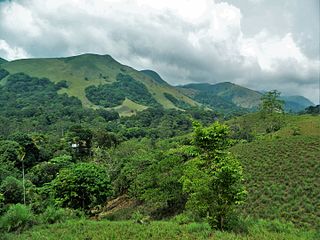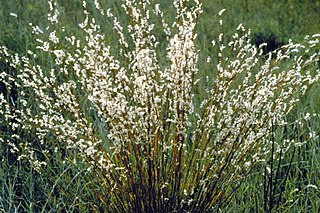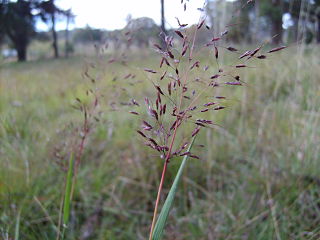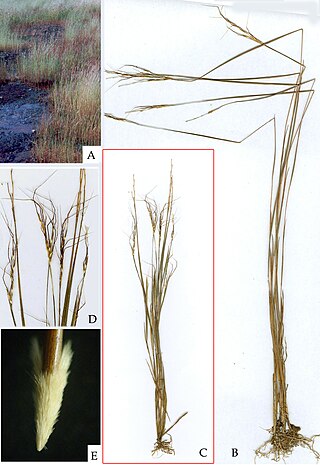
Saccharum is a genus of tall perennial plants of the broomsedge tribe within the grass family.

Sholas are the local name for patches of stunted tropical montane forest found in valleys amid rolling grassland in the higher montane regions of South India, largely in Kerala, Karnataka and Tamilnadu. These patches of shola forest are found mainly in the valleys and are usually separated from one another by undulating montane grassland. The shola and grassland together form the shola-grassland complex or mosaic. Not all such high-elevation grasslands have sholas in their valleys, especially if they are isolated from other such meadows, such as the meadows found in the Idamalayar Reserve Forest in Ernakulam district of Kerala. The word 'Shola' is probably derived from the Tamil language word cōlai (சோலை) meaning grove.

The Andropogoneae, sometimes called the sorghum tribe, are a large tribe of grasses (family Poaceae) with roughly 1,200 species in 90 genera, mainly distributed in tropical and subtropical areas. They include such important crops as maize (corn), sugarcane, and sorghum. All species in this tribe use C4 carbon fixation, which makes them competitive under warm, high-light conditions.
The term Malabar rainforests refers to one or more distinct ecoregions recognized by biogeographers:
- the Malabar Coast moist forests formerly occupied the coastal zone to the 250 metre elevation
- the South Western Ghats moist deciduous forests grow at intermediate elevations
- the South Western Ghats montane rain forests cover the areas above 1000 metres elevation

Bothriochloa is a common and widespread genus of plants in the grass family native to many countries on all inhabited continents and many islands. They are often called beardgrass, bluegrass or bluestem. Some species are invasive in areas where they have been introduced.

Dactyloctenium is a genus of Asian, African, and Australian plants in the grass family. There are about 13 species in the genus in the world, in which 3 are known to occur in India. A common name for the plants is crowfoot grasses.

Chloris is a widespread genus of monophyletic grasses belonging to the family Poaceae, known generally as windmill grass or finger grass. The genus is found worldwide, but especially in the tropical and subtropical regions, and more often in the Southern Hemisphere. The species are variable in morphology, but in general, the plants are less than 0.5 m in height. They bear inflorescences shaped like umbels, with several plumes lined with rows of spikelets. The genus is characterized by the series of sterile florets above the lowest fertile ones, spikes usually 4–10 in numbers, approximated or in a slightly separated series of 10–20 spikes, rarely an indefinite numbers of terminal spikes. In India, 11 species are known to occur in which only two are endemic viz. Chloris wightiana Nees ex Steud. and Chloris bournei Rangachariar & Tadulingam.

Capillipedium is a genus of plants in the grass family. They are native to Africa, Asia, Australia, and certain islands in the Western Pacific.

Chrysopogon is a genus of tropical and subtropical plants in the grass family. They are widespread across Eurasia, Africa, Australia, southeastern North America, and various islands.
Lophopogon is a ditypic genus endemic to India, consisting of two well-known species Lophopogon tridentatus (Roxb.) Hackel and Lophopogon kingii Hook f. belonging to the tribe Andropogoneae in the grass family.
Louisiella is a genus of African, Neotropical and tropical plants in the grass family. Earlier the genus was known to comprise only two species i.e. L. fluitans and L. elephantipes.Mr. Shahid Nawaz, an agrostologist at the Blatter Herbarium (BLAT), transferred a species Panicum paludosum Roxb. into Louisiella based on critical study of the morphological features. Now, there are three globally accepted species in the genus.

Dimeria is a genus of Asian, Australian, Madagascan, and Pacific Island plants in the grass family, mostly distributed in Peninsular India
Parahyparrhenia is a genus of Afro-Asian plants in the grass family. Globally, the genus comprises seven species. Two species are known to occur in India where they are narrow endemic. The species show disjunct distribution in Africa and Asia. Parahyparrhenia bellariensis (Hack.) Clayton an extremely rare grass which was presumed extinct was rediscovered by Mr. Shahid Nawaz, an agrostologist after the span of 184 years from its type locality in the state of Andhra Pradesh, South India. Following its rediscovery, it has been classified as Critically Endangered (CR) by following the guidelines of IUCN Criteria and Category.

Glyphochloa is a genus of Indian plants in the grass family.

Ranixalidae is a family of frogs commonly known as the leaping frogs or Indian frogs. They are endemic to central and southern India, specifically in the Western Ghat mountain range. This mountain range encompasses the Indian states of Gujarat, Maharashtra, Goa, Karnataka, Kerala, and Tamil Nadu. Ranixalidae can be found in Maharashtra, Goa, Karnataka, and Kerala. There is a large concentration of them in Goa and Maharashtra, however there are still considerable amounts of species within the southern Indian states of Karnataka and Kerala, where there are other frogs within the Indirana genus.

Capillipedium spicigerum, commonly known as scented-top grass, is a species of perennial grass in the family Poaceae that is native to Australia.

Ischaemum rugosum, also known as saramollagrass, is a flowering plant belonging to the grass family Poaceae in the genus Ischaemum, and is native to tropical and temperate regions of Asia, growing in marshes and other wet habitats. It is a vigorous annual, and is an invasive species in South America and Madagascar. It reaches heights of up to 1 m and is primarily recognized by the ridged surface of its sessile spikelet’s lower glume. Despite its historic importance as fodder in Asia, the grass has become a major weed in mid-latitude rice paddies throughout Asia and South America.

Rottboellia cochinchinensis is a species of grass known by the common names Itchgrass,Raoul grass, corngrass, Kokoma grass, Guinea-fowl grass, jointed grass, Shamwa grass and Kelly grass. It is a tall, tufted annual grass whose stems (culms) grow up to 3 metres in height with leaf-blades of up to 45 centimetres in length. The species flowers at the apex of culms in the form of spike-like racemes composed of paired spikelets. The common name Itchgrass comes from the bristly (hispid) leaf-sheath which can be irritating to the skin.

Nanooravia is a monotypic genus of flowering plants belonging to the family Poaceae. The only species is Nanooravia santapaui, an annual grass, and its native range is Southern India.















